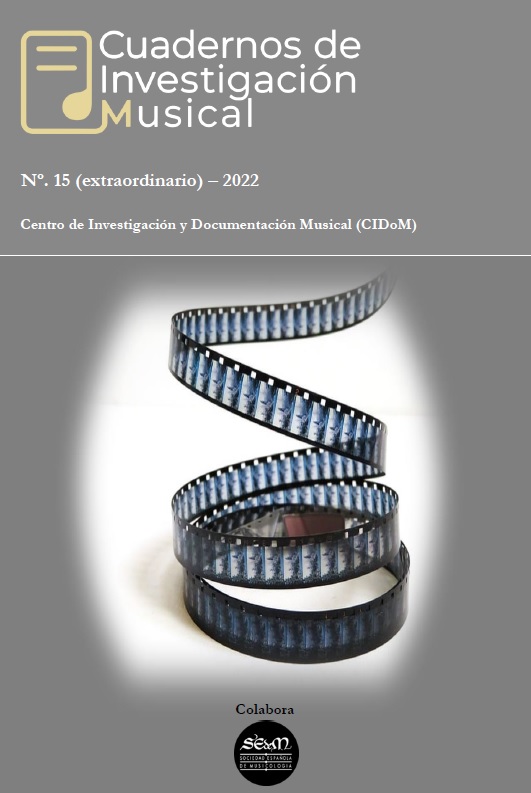Intertextual Signifiers in the Soundtrack of Bernardo Bonezzi: Paradigm of Pedro Almodóvar’s Cinema
Main Article Content
Abstract
Despite his recognizable compositional skills, Bernardo Bonezzi could not escape the influence of great classical and film composers. Thus, several of his works, especially those from Pedro Almodóvar’s films, are imbued with the compositional language of Nino Rota, Bernard Hermann, Erik Satie and Igor Stravinsky. First, the borrowed musical references are identified and then placed in a new socio-historical, geographical and cultural-ideological context. The use of the waltz “What have I done to deserve this?”, composed as part of the intertextual interweaving of the soundtrack of various cult films, is analyzed in detail. In this paper, a new method of analysis is applied in which pre-existing sound resources are given new sensory, affective and conceptual meaning. It is thus possible to decipher the intertextual chains of signifiers in “Bonezzian” music and determine whether there is an authentic authorial voice in it.
Article Details
Los autores de los artículos mantienen el copyright, no recibirán ninguna contraprestación económica por el trabajo y el mismo siempre será reconocido como exclusivamente suyo. La revista se compromete a proteger la integridad y originalidad del artículo, así como los derechos de autor que correspondan. Los autores son los únicos responsables del material, textos e imágenes que utilizan en sus respectivos trabajos, debiendo respetar siempre los derechos de autor de terceras personas, por lo que la revista no se hace responsable de lo contenido en este tema respecto al trabajo de los autores.
References
Allen, G. (2011). Intertextuality (2nd edition). New York: Routledge.
Bakhtin, M. (1984). Problems of Dostoevsky’s Poetics. Minneapolis: University of Minnesota Press.
Barthes, R. (1999). La muerte del autor. En El susurro del lenguaje. Más allá de la palabra y la escritura (pp. 65-71). Barcelona: Paidós.
Bonezzi, B. (1986). Composición en rojo (Para la película “Matador”). Partitura manuscrita, Madrid: SGAE.
Buljančević, R. (2022). Construcción y aproximación musical a las identidades frágiles en la película dramática Todo sobre mi madre. En Cuadernos de Investigación Musical, (14), pp. 267-295. https://doi.org/10.18239/invesmusic.2022.14.08.
Davis, M. E. (2007). Erik Satie. London: Reaktion Books.
Dolar, M. (2006). A Voice and Nothing More. Cambridge: MIT Press.
Dunne, M. (2001). Intertextual Encounters in American Fiction, Film, and Popular Culture. Bowling Green: Bowling Green State University Press.
Fernández Uribe, C. A. (2008). Concepto de arte e idea de progreso en la historia del arte. Antioquia: Universidad de Antioquia.
Foucault, M. (1978). Las palabras y las cosas. Mexico: Siglo XXI.
Foucault, M. (1999). ¿Qué es un autor? En Entre filosofía y literatura. Obras esenciales 1, Barcelona: Paidós, pp. 329-360.
Fuld, J. J. (2000). The Book of World-famous Music: Classical, Popular, and Folk. New York: Dover Publications.
Genette, G. (1997). Palimpsests: Literature in the Second Degree. Lincoln, NB: University of Nebraska Press.
Gorospe, J. (s.f.). [Fotografía de Bernardo Bonezzi].
Holguín, A. (1994). Pedro Almodóvar. Madrid: Ediciones Cátedra.
Jarmusch, J. (2016). Things I’ve Learned: Jim Jarmusch. En MovieMaker Magazine, 26. 10. 2016. Recuperado de https://www.moviemaker.com/jim-jarmusch-5-golden-rules-of-moviemaking/.
Jiménez Arévalo, A. (2020). Música y cine posmoderno español: diálogos intertextuales, pliegues de la historia y paisajes sonoros. (Tesis Doctoral). Madrid: Universidad Complutense de Madrid, Facultad de Geografía e Historia. Recuperado de https://eprints.ucm.es/id/eprint/65025/1/T42247.pdf.
Juvan, M. (2008). History and poetics of intertextuality. Indiana: Purdue University Press.
Kostka, V., de Castro, P. F. & Everett, W. A. (Eds.) (2021). Intertextuality in Music: Dialogic Composition. London: Routledge.
Kristeva, J. (1969/1978). Semiótica 1. Madrid: Editorial Fundamentos.
Maia, G. (2010). Do ‘lixo’ ao luxo: um ensaio sobre a música de pós-produção nos almodramas. En Contemporanea – Revista de Comunicação e Cultura 8 (2), pp. 1-33. Recuperado de https://portalseer.ufba.br/index.php/contemporaneaposcom/article/view/4819/3576.
Padrol, J. (2006). Conversaciones con músicos de cine. Bajadoz: Diputación Provincial de Badajoz.
Quiñones, A. (2018). Sindo Garay cuenta cómo Ojos negros que fascinan se convirtió en la popular canción rusa Ochi chornie. En Nota Clave: El periódico digital, 25. 03. 2018. Recupeado de https://notaclave.com/sindo-garay-cuenta-de-como-ojos-negros-que-fascinan-se-convirtio-en-la-popular-cancion-rusa-ochi-chornie/.
Sánchez Noriega, J. L. (2017). Universo Almodóvar. Estética de la pasión en un cineasta posmoderno. Madrid: Alianza Editorial.
Tintner, A. R. (1999). Edith Wharton in Context: Essays on Intertextuality. Tuscaloosa: University of Alabama Press.
Turim, M. (1985). Gentlemen Consume Blonds. En Bill Nichols (Ed.), Movies and Methods, Volume 2 (pp. 369-378). Berkeley: University of California Press.
Vernon, K. M. (1993). Melodrama against Itself: Pedro Almodóvar’s “What Have I Done to Deserve This?”. Film Quarterly 46 (3), pp. 28-40.
Vidal, N. (1989). El cine de Pedro Almodóvar. Barcelona: Destino.
Weinstein, D. (1988). The History of Rock’s Pasts through Rock Covers. En T. Swiss, J. Sloop & A. Herman (Eds.), Mapping the Beat: Popular Music and Contemporary Theory (pp. 137-152). Malden, MA: Blackwell.
Xalabarder, C. (2012). A Look Back Without Anger. Interview with Bernardo Bonezzi. En MundoBSO, 20. 1. 2012. Recuperado de https://mundobso.wordpress.com/2012/01/20/a-look-back-without-anger-interview-with-bernardo-bonezzi/.
Žižek, S. (2003). El sublime objeto de la ideología. Buenos Aires: Siglo XXI.
MATERIAL AUDIOVISUAL
Almodóvar, P & McNamara, F. (1982-83/2005). ¡Cómo está el servicio… de señoras! [CD]. Madrid: Discos Lollipop, 2005.
Almodóvar, P. (1984). ¿Qué he hecho yo para merecer esto? [DVD]. Madrid: Kaktus Producciones Cinematográficas, Tesauro S.A.
Almodóvar, P. (1986). Matador. [DVD]. Madrid: Compañía Iberoamericana de TV y Televisión Española (TVE).
Almodóvar, P. (1988). Mujeres al borde de un ataque de nervios [DVD]. España: El Deseo, Laurenfilm.
Bonezzi, B. (2004). Almodóvar Early Films [CD]. Madrid: Karonte Distribuciones.
